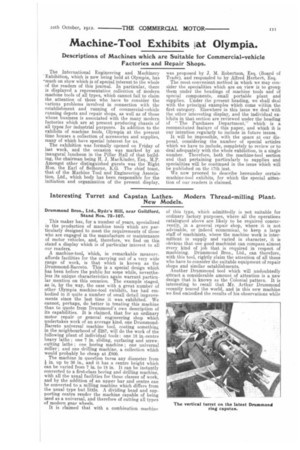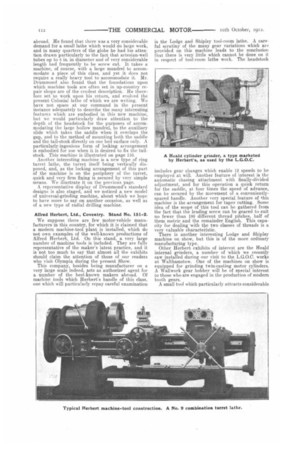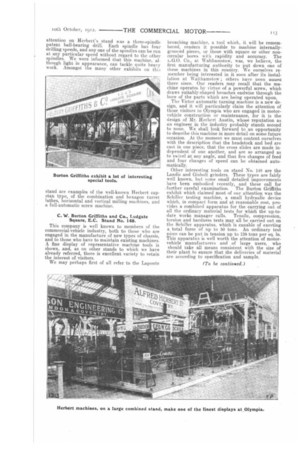Interesting Turret and Capstan Lathes. Modern Thread-milling Plant.
Page 9

Page 10

Page 11

If you've noticed an error in this article please click here to report it so we can fix it.
New Models.
Drummond Bros., Ltd., Ryde's Hill, near Guildford, Stand Nos. 72-,107.
This maker has, for a number of years, specialized in the production of machine tools which are particularly designed to meet the requirements of those who are engaged in the manufacture or maintenance of motor vehicles, and, therefore, we find on this stand a display which is of particular interest to all our readers.
A machine-tool, which, in remarkable measure. affords facilities for the carrying out 4 a very wide range of work, is that which is known as the Drummond-Barreto. This is a special design which has been before the public for some while, nevertheless its unique characteristics again warrant particular mention on this occasion. The example staged, as is, by the way, the case with a great number of other Olympia machine-tool exhibits, has had embodied in it quite a number of small detail improvements since the last time it was exhibited. We cannot, perhaps, do better in treating this machine than to quote from Drummond's own description of its capabilities. It is claimed, that for an ordinary motor repair or general engineering shop which undertakes work of an average kind, one DrummondBarreto universal machine tool, costing something, in the neighbourhood of 2257, will do the work of the following plant of individual tools : one 18 in.-centre heavy lathe ; one 7 in. sliding, surfacing and screwcutting lathe ; one boring machine ; one universal miller ; and one drilling machine, a collection which would probably be cheap at ;£800. The machine in question turns any diameter from I in. up to 36 in., and it has a centre height which can be varied from 7 in. to 18 in. It can be instantly converted to a first-class boring and drilling machine, with all the usual facilities for those classes of work, and by the addition of an upper bar and centre can be converted to a milling machine which differs from the usual type but little. A dividing head and supporting centre render the machine capable of being used as a universal, and therefore of cutting all types of modern gear wheels. It is claimed that with a combination machine
of this type, which admittedly is not suitable for ordinary factory purposes, where all the operations catalogued above are likely to be required concurrently, in a general repair shop, where it is not advisable, or indeed. economical, to keep a large staff of machinists, where the machine work is intermittent in supply and varied in character, it is obvious that one good machinist can compass almost every kind of job that is required in respect of machining. Drummond Bros., Ltd., can therefore, with this tool, rightly claim the attention of all those who have to consider the suitable equipment of repair shops and similar establishments. Another Drummond tool which will undoubtedly attract a considerable amount of attention is a new design that is known as the Colonial pattern. It is interesting to recall that Mr. Arthur Drummond recently toured the world, and in this new machine we rind embodied the results of his observations while abroad. He found that there was a very considerable demand for a small lathe which would do large work, and in many quarters of the globe he had his attention drawn particularly to the fact that artesian-well tubes up to 4 in. in diameter and of very considerable length had frequently to be screw cut. It takes a machine, of course, with a large mandrel to accommodate a piece of this class, and yet it does not require a really heavy tool to•accommodate it. Mr. Drummond also found that the foundations upon which machine tools are often set in up-country repair shops are of the crudest description. He therefore set to work upon his return, and evolved the present Colonial lathe of which we are writing. We have not space at our command in the present instance adequately to describe the many interesting features which are embodied in this new machine, but we would particularly draw attention to the depth of the headstock for the purposes of accommodating the large hollow mandrel, to the auxiliary slide which takes the saddle when it overlaps the gap, and to the method of mounting both the saddle and the tail-stock directly on one bed surface only A particularly-ingenious form of locking arrangement is embodied for use when it is desired to fix the tailstock. This machine is illustrated on page 110.
Another interesting machine is a. new type of ring turret lathe, the turret itself being vertically disposed, and, as the locking arrangement of this part of the machine is on the periphery of the turret, quick and very firm fixing is secured by very simple means. We illustrate it on the previous page. A representative display of Drummond's standard designs is also staged, and we noticed a new model of universal-grinding machine, about which we hope to have more to say on another occasion, as well as of a new type of radial drilling machine.
Allred Herbert, Ltd., Coventry. Stand No, 151-2.
We suppose there are few motor-vehicle manufacturers in this country, for which it is claimed that a modern machine-tool plant is installed, which do not own examples of the well-known productions. of Alfred Herbert, Ltd. On this stand, a very large number of machine tools is included. They are fully representative of the maker's latest practice, and it is not too much to say that almost all the exhibits should claim the attention of those of our readers who visit Olympia during the present Show. This company, besides being manufacturer on a very large scale indeed, acts as authorized agent. for a number of the best-known makers abroad. Of machine tools which Herbert's handle of this class, one which will particularly repay careful examination is the Lodge and Shipley tool-room lathe. A careful scrutiny of the many gear variations which are provided on this machine leads to the conclusion that there is very little which cannot be done on it in respect of tool-room lathe work. The headstock
includes gear changes which enable 12 speeds to be employed at will. Another feature of interest is the automatic chasing attachment with finally-divided adjustment, and for this operation a quick return for the saddle, at four times the speed of advance, can be secured by the movement of a convenientlyspaced handle. Another very special feature of this machine is the arrangement for taper cutting. Some idea of the scope of this tool can be gathered from the fact that the leading screw can be geared to suit no fewer than 180 different thread pitches, half of them metric and the remainder English. This capacity for dealing with tbe two classes of threads is a very valuable characteristic.
There is another interesting Lodge and Shipley machine on show, but this is of the more ordinary manufacturing type.
Other Herbert exhibits of interest are the Heald internal grinders, a number of which we recently saw installed during our visit to the L.G.O.C. works at Walthamstow. One of the machines on show is equipped for grinding twin-casting motor cylinders. A Wallwork gear hobber will be of special interest to those who are engaged in the production of modern tooth gears.
A small tool which particularly attracts considerable attention on Herbeit's stand was a three-spindle patent ball-bearing drill. Each spindle has four drilling speeds, and any one of the spindles can be run at any particular speed without regard to the other spindles. We were informed that this machine, although light in appearance, can tackle quite heavy work. Amongst the many other exhibits on tin; stand are examples of the well-known Herbert capstan type, of the combination and hexagon turret lathes, horizontal and vertical milling machines, and a full-automatic screw machine.
C. W. Burton Griffiths and Co., Ludgate Square, E.G. Stand No. 148.
This company is well known to members of the commercial-vehicle industry, both to those who are engaged in the manufacture of new types of chassis, and to those who have to maintain existing machines. A fine display of representative machine tools is shown, and, as on other stands to which we have already referred, there is excellent variety to retain the interest of visitors.
We may perhaps first of all refer to the La,ponte
broaching machine, a tool which, it, will be remembered, renders it possible to machine internallygrooved pieces, or those with square or other noncircular bores with rapidity and accuracy. The L.G.O. Co., at Walthamstow, was, we believe, the first manufacturing authority to put down one of these. machines in this country. We ourselves remember being interested in it soon after its installation at Walthamstow ; others have been actuoct there since. Our readers may recall that the machine operates by virtue of a powerful screw, which draws suitably-shaped broaches endwise through the bore of the parts which are being operated upon.
The Victor automatic turning machine is a new design, and it will particularly claim the attention of those visitors to Olympia who are engaged in motorvehicle construction or maintenance, for it is the design of Mr. Herbert Austin, whose reputation as an engineer in the industry probably stands second to none. We shall look forward to an opportunity to describe this machine in more detail on some future occasion. At the moment we must content ourselves with the description that the headstock and bed are east in one piece, that the cross slides are made independent of one another, and are so arranged as to swivel at any angle, and that five changes of feed and four changes of speed can be obtained automatically.
Other interesting tools on stand No. 148 are the Landis and Gisholt grinders. These types are fairly well known, but s.ome small detailed improvements have been embodied recently, and these call for
• further careful examination. The Burton Griffiths exhibit which claimed most of our attention was the Schiller testing machine, a small hydraulic device which, in compact form and at reasonable cost, provides a combined apparatus for the carrying out of all the ordinary material tests for which the up-todate works manager calls. Tensile, compression, torsion and hardness tests may all be carried out on the Schiller apparatus, which is capable of exerting a total force of up to 50 tonsAn ordinary test piece can be put in tension up to 138 tons per sq. in. This apparatus is well worth the attention of motorvehicle manufacturers and of large users, who should take all means consistent with the size of their plant to ensure that the deliveries of material are according to specification and sample.


























